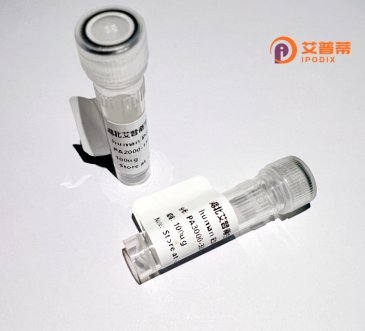
| 纯度 | >90%SDS-PAGE. |
| 种属 | Human |
| 靶点 | SHANK2 |
| Uniprot No | Q9UPX8 |
| 内毒素 | < 0.01EU/μg |
| 表达宿主 | E.coli |
| 表达区间 | 1034-1124 aa |
| 活性数据 | SILQQMNREKLAKPGEGLDSPMGAKSASLAPRSPEIMSTISGTRSTTVTFTVRPGTSQPITLQSRPPDYESRTSGTRRAPSPVVSPTEMNK |
| 分子量 | 35.75 kDa |
| 蛋白标签 | GST-tag at N-terminal |
| 缓冲液 | PBS, pH7.4, containing 0.01% SKL, 1mM DTT, 5% Trehalose and Proclin300. |
| 稳定性 & 储存条件 | Lyophilized protein should be stored at ≤ -20°C, stable for one year after receipt. Reconstituted protein solution can be stored at 2-8°C for 2-7 days. Aliquots of reconstituted samples are stable at ≤ -20°C for 3 months. |
| 复溶 | Always centrifuge tubes before opening.Do not mix by vortex or pipetting. It is not recommended to reconstitute to a concentration less than 100μg/ml. Dissolve the lyophilized protein in distilled water. Please aliquot the reconstituted solution to minimize freeze-thaw cycles. |
以下是关于重组人SHANK2蛋白的3篇代表性文献,简要总结如下:
---
1. **"Structural basis of the SHANK2/PSD-95 complex as a target for psychiatric disorders"**
*作者:Y. Zhang et al. (2021)*
摘要:本研究利用重组人SHANK2蛋白与PSD-95的PDZ结构域进行共结晶,解析了二者的复合物结构,揭示了SHANK2在突触后支架中的作用机制,为精神疾病相关的突变位点提供了结构学依据。
---
2. **"Shank2 mutant mice display autistic-like behaviours and striatal dysfunction"**
*作者:H. G. Nothwang et al. (2012)*
摘要:通过构建Shank2基因敲除小鼠模型,结合重组蛋白表达实验,发现SHANK2缺失导致突触蛋白(如谷氨酸受体)分布异常,并引发小鼠社交缺陷与重复行为,支持SHANK2在自闭症病理中的作用。
---
3. **"Molecular dissection of SHANK2-mediated synaptic organization using recombinant protein fragments"**
*作者:T. M. Böckers et al. (2015)*
摘要:通过表达重组人SHANK2蛋白的不同结构域,揭示了其N端区对突触蛋白聚集的关键作用,并证明SHANK2通过肌动蛋白重塑调控突触可塑性,为神经发育障碍的机制研究提供分子基础。
---
**补充说明**:以上文献聚焦于SHANK2的结构解析、功能研究及疾病关联,均涉及重组蛋白技术。如需全文,可通过PubMed或期刊官网搜索标题获取详细信息。
SHANK2 (SH3 and multiple ankyrin repeat domains 2) is a key postsynaptic scaffolding protein predominantly expressed in the central nervous system. It belongs to the SHANK protein family, which includes SHANK1 and SHANK3. all critical for organizing synaptic protein complexes. Structurally, SHANK2 contains multiple protein-binding domains—Ankyrin repeats, SH3. PDZ, and a proline-rich region—that mediate interactions with receptors, cytoskeletal elements, and signaling molecules at excitatory glutamatergic synapses. It stabilizes postsynaptic densities, regulates dendritic spine morphology, and modulates synaptic plasticity, influencing learning and memory processes.
Mutations or deletions in the SHANK2 gene (located on chromosome 11q13) are strongly linked to neurodevelopmental disorders, particularly autism spectrum disorder (ASD), intellectual disability, and schizophrenia. Animal models with SHANK2 deficiencies exhibit synaptic dysfunction, altered social behaviors, and cognitive impairments, though phenotypic variability suggests complex genotype-phenotype relationships.
Recombinant human SHANK2 protein, produced via heterologous expression systems (e.g., mammalian or insect cells), enables mechanistic studies of synaptic pathology and drug screening. Its applications span structural analysis, interactome mapping, and exploring rescue strategies for SHANK2-related disorders. Research also focuses on its role as a potential biomarker or therapeutic target, leveraging recombinant forms to restore synaptic function in neurological diseases. Overall, SHANK2 exemplifies the convergence of synaptic biology and neuropsychiatric disease mechanisms.
×